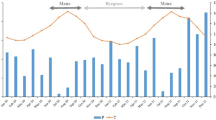Abstract
The nutrient mining abilities of six Musa genotypes: ‘Agbagba’, ‘PITA 22’, ‘Nsukka Local’, ‘FHIA 17’, ‘Fougamou’, and ‘BITA 7’, grown in organic medium formulated by decomposing rice husks with poultry manure in volume proportions of 3:2, were determined at the Teaching and Research Farm of the Department of Crop Science, University of Nigeria, Nsukka, Nigeria. Results indicated significant variation in nutrient mining with respect to Musa genotype and duration of growth. The medium previously cropped with ‘Agbagba’ recorded highest residual mean values for P and Ca, while the medium cropped with ‘Fougamou’ had the highest residual concentration of Mg and S. Residual amount of K was highest in the medium where ‘PITA 22’ and ‘Nsukka Local’ were previously grown. Peak residual concentration of P and K occurred in the medium in which Musa plants were grown only for 4 months, decreasing thereafter, in contrast to Ca, Mg, and S. Residual N tended to increase with longer growth duration of the Musa crops. Follower crop of maize grown in the medium previously cropped with Musa genotypes showed variable performance. While medium previously cropped with ‘PITA 22’ and ‘BITA 7’ favored growth attributes and leaf greenness of the follower maize plant, ‘Fougamou’ favored maize fresh weight attributes. Ectomycorrhiza association was observed in medium previously cropped to ‘BITA 7’ and ‘PITA 22’. Generally, ‘Agbagba’ and ‘Fougamou’ seemed to be the most reticent nutrient miners while uptake of P and K appeared to be low 4 months after planting (MAP) in contrast to Ca, Mg, and S uptake. However, substrate previously cropped with ‘PITA 22’, ‘BITA 7’ and ‘Fougamou’ gave rise to superior growth and fresh weight attributes, respectively, of the maize, the follower crop. A prospect of utilizing the ectomycorrhiza association observed with some genotypes to upgrade Musa yields and those of associated or follower crops exist.
Similar content being viewed by others
References
AOAC. 1980. Association of Analytical Chemistry (AOAC), Official methods of analysis, 4th ed., Washington DC, USA
Baiyeri KP. 1996. Water stress effects on plantain (Musa spp AAB) suckers grown under varying nitrogen and watering regime. Afr. Crop Sci. J. 4: 159–166
Baiyeri KP, Mbah BN, Tenkouano A. 2000. Yield components of triploid and tetraploid Musa genotypes in Nigeria. Hort. Sci. 35: 1338–1343
Baiyeri KP, Tenkouano A. 2007. Manure placement influenced growth and dry matter yield of a plantain hybrid. Afr. Crop Sci. Conf. Proc. 8: 385–390
Baiyeri KP, Tenkouano A. 2008a. Fruit characteristics and ripening pattern of ten Musa genotypes in a sub-humid environment in Nigeria. Fruits 63: 3–9
Baiyeri KP, Tenkouano A. 2008b. Genetic and cropping cycle effects on proximate and antinutrient contents of flour made from eleven Musa genotypes. Global J. Pure Appl. Sci. 12: 177–182
Baiyeri KP, Ugese FD, Uchendu TO. 2011. The effects of previous fertilizer treatments on passion fruit seed quality, and seedling emergence and growth qualities in soilless media. J. Agric. Technol. 7: 2201–2211
Bhadoria PBS. 2003. Phosphorus uptake and growth of maize as influenced by fumigant application. Madras Agric. J. 90: 182–184
Brady NC. 1990. The Nature and Properties of Soils, 10th Ed. Macmillan Publishing Co. New York. pp 621
Brandjes P, Van Dongen P, Yan de Veer A. 1989. Green manuring and other forms of soil improvement in the tropics. Agromisa Agrodok 28, Netherlands, p33
ENCARTA. 2009. Microsoft Encarta Premium 2009 FAO 1991. Production Year Book 1991. Food and Agriculture Organization of the United Nations, Rome
Fixen P.E, Reetz HF. 2006. Fertilizer best management practices — making the best better. Better Crops 90: 3
Francis R, Read DJ. 1984. Direct transfer of carbon between plants connected by VAM mycelium. Nature 307: 53–56
GENSTAT. 2003. GENSTAT 5.0 Release 4.23 DE, Discovery Edition 1, Lawes Agricultural Trust, Rothamstead Experimental Station
INIBAP. 1992. International Network for the Improvement of Banana and Plantain. Annual Report, 1992. Montpellier, France
Omar SA. 1995. Growtth effects of the versicular-arbuscular mycorrhizal fungus Glomus constrictum on maize plants in pot trials. Folia Microbiol. 40: 503–507
Roberts MBV. 1976. Biology: A Functional Approach (Second edition). Thomas Nelson and Sons Ltd., Singapore, pp 656
Samson JA. 1980. Tropical Fruits. Longman Group Limited, London, pp 250
Shaibu AA, Udu P, Tenkouano A, Ogburia MN, Osakwe JA. 2006. Evaluation of agronomic performance of Musa genotypes under two agroecologies of Nigeria. Proc. 23rd Ann. Conf. Hort. Soc. Nigeria. pp318–322
Tenkouano A, Baiyeri KP. 2007. Adaptation pattern and yield stability of banana and plantain genotypes grown in contrasting agroecologies in Nigeria. Afr. Crop Sci. Proc. 8: 377–384
Uriyo, AP, Singh, BR. and Kimambo, A. E. 1977. Evaluation of P placement methods, N carriers and NP effects on soil, maize yield and N. P. K. in leaves. East Afr. Agric. For. J. 42: 353–358
van Ee, S. 1999. Fruit Growing in the Tropics, 2nd Ed. Agrodok series No. 5., Agromisa Foundation, pp 88
van Kessel C, Sigleton PW, Hoben HJ. 1985. Enhance N-transfer from soybean to maize by VAM fungi. Plant Physiol. 79: 562–563
Wiley, RW. 1979. Intercropping — its importance and its research needs. Part 1. Competition and yield advantages. Part 2. Agronomic relationships. Field Crop Abstr. 32
Wilson GF. 1987. Status of bananas and plantains in West Africa. In GJ Persley, EA De Langhe, eds, Banana and Plantain Breeding Strategies. ACIAR Proc. No. 21: 28–32
Young CC, Juang TC Guo HY. 1986. Vesicular-arbuscular mycorrhiza inoculation, soybean yield and mineral P utilization in sub tropical soils. Plant Soil 95: 245–254
Author information
Authors and Affiliations
Corresponding author
Rights and permissions
About this article
Cite this article
Ortese, E., Baiyeri, P.K. & Ugese, F.D. Residual macronutrient concentration and follower maize (Zea mays) crop performance in soilless growth medium previously cropped with six Musa genotypes. J. Crop Sci. Biotechnol. 14, 321–327 (2011). https://doi.org/10.1007/s12892-010-0112-x
Received:
Revised:
Accepted:
Published:
Issue Date:
DOI: https://doi.org/10.1007/s12892-010-0112-x




